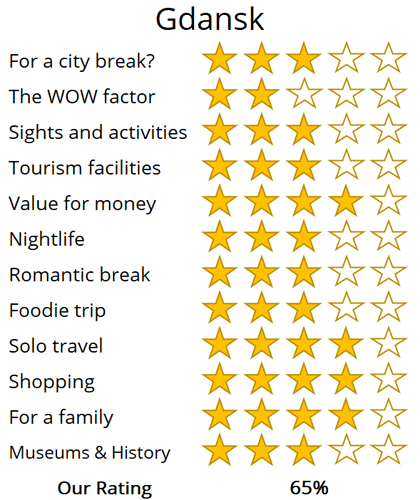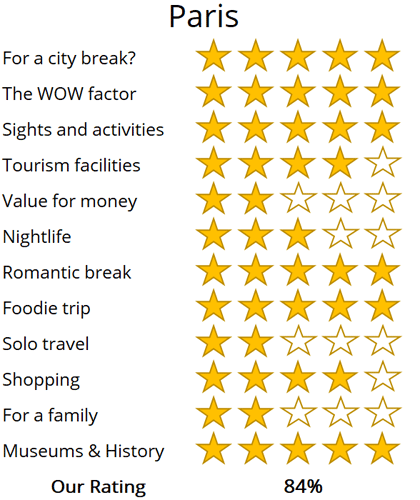WhereToGoForMyHoliday.com
The best destination comparison site!
WhereToGoForMyHoliday.com
The best destination comparison site!
Gdansk or Paris a vs city comparison and travel guide
Gdansk and Paris both offer unique and enticing experiences, but which one should you choose for your city break or holiday?
We understand your dilemma. There is an abundance of travel guides for both cities, but few actually comparing them, and advising you which is the better for your trip.
This article will provide our unbiased and independent views of Paris and Gdansk, hopefully making your choice that little easier.
The article is structured into several sections, each of which can be directly accessed through the following links:
• Introduction to the cities
• Scores and ratings
• Which one should I, friends, or family visit?
• When to visit and weather
• Who is the city suited for?
• The perfect 48hours (with map)
• Tourism details (where to stay? airport details?)
Introduction to Gdansk and Paris
Salt-washed, industrial-chic and filled with hipsters, Gdansk is one of the most happening cities in Poland. It sits on the edge of the Baltic Sea, proudly showcasing its merchant guilds and mansions, a leftover from the years when this was one of the richest ports in the Hanseatic League.
Like most Polish cities, the focal point is an immersive Old Town (also called the Main City) that beats with life and cafés and boutique shops.
Around that's a newer city where the remnants of Communist rule still pop up in the tenement blocks and the famous dockyards where the Solidarity movement heralded the beginning of the end for the USSR in the 1980s.
On top of all the architecture and culture is a vibey bar scene that's powered by a hefty student population. There are clubs and pubs everywhere, from the open-air boats on the quaysides to the hidden basement bars in the old quarter.
What's more, Gdansk is the gateway to the Polish coast, with Hel Peninsular and its oat-topped dunes close by, or the resort town of Sopot only a short train ride away.
Paris is famed as the capital of Romance, the epicentre of French culture and grand European art, and the home of iconic monuments like the Eiffel Tower. There's no question that it's an amazing city to explore.
Everywhere you go along the Seine River it seems like there's a world-class museum or gallery beckoning. But Paris can also be overwhelming, not to mention downright gritty in some parts.
The history here goes back to the Celtic tribes of the 400s BC. But it was the 7th-century fortifications on the Île de la Cité that went on to form the medieval kernel of the town.
The capital still radiates out from that, with bohemian neighborhoods along the Canal Saint-Martin, stereotypically Parisian cafes and cobbled streets in Montmartre, and enthralling cultural and foodie attractions throughout other arrondissements (areas).
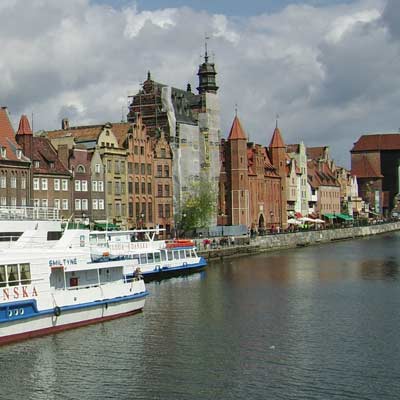
The scenic Długa waterfront in Gdansk
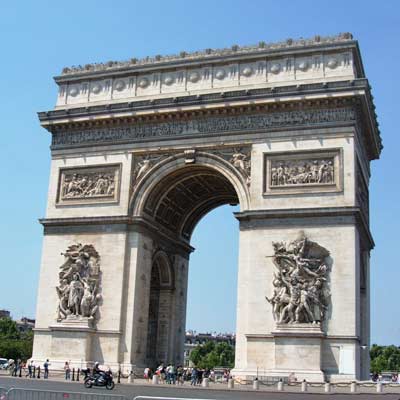
The Arc de Triomphe, constructed as a memorial to the soldiers who perished in the Napoleonic Wars and French Revolution
Gdansk vs Paris: City Ratings
Summary
Where would I journey for a personal escape?
Paris
Where would I send my parents for a memorable visit?
Paris
Where's the ideal destination for my adventurous 19-year-old cousin?
Gdansk
Where should my food-obsessed friend indulge their culinary passions?
Paris
Note: The above comparisons are weather-independent and are based on travel during the most opportune times of the year. Details about the ideal travel seasons are elaborated upon later in this article.
In the sections that follow, you'll find a comprehensive comparison between these two fascinating cities. This includes recommendations on the duration of stay, the best times to visit, and tailored 48-hour itineraries for each city.
The final segment delves into practicalities for your travels, such as the best airport to fly into, the optimal districts for your accommodation, and insider tips, for when you come to explore the city.
We hope that you find all of this information useful, in planning your next exciting trip!
Destination details
How long to spend each city?
Paris could take a lifetime to explore completely. This is a living, breathing, sprawling capital city, which means even the locals can be surprised at the new cafes, bistros, and cultural events that come and go. For travellers, at least three days is a good idea.
That's probably just enough to see the mainstay sights and hop into the Louvre to catch a glimpse of the Mona Lisa. Trips to explore outer arrondissements and sample Paris's pumping nightlife should probably be between four days and a whole week, with more extensions needed if you want to hit the Loire Valley for wine tasting.
Gdansk can be done in just a couple of days, but don't expect that to be enough to do everything. You'll likely want to linger longer, if only to beachcomb the Baltic coast, explore the other corners of the Tri-City (Gdansk is just one of three individual towns that are joined together), and sample as many of the cool hipster bars as you can.
Still, city breaks are very much doable here. Just 48 or 72 hours is ample for checking off the historic sights in the centre, the fascinating dockyards monuments, and to get a feel for the unique fusion of Slavic-Germanic architecture that abounds. Expect to do a lot of walking, though, and be ready to hop on inner-city trains and trams to get from A to B.
During the summertime, you could opt to do as thousands of Polish locals do and extend your Gdansk holiday to a week or two. That'll let you head out to the coast and the beaches. They can be surprisingly stunning, especially along the breezy Hel headland.
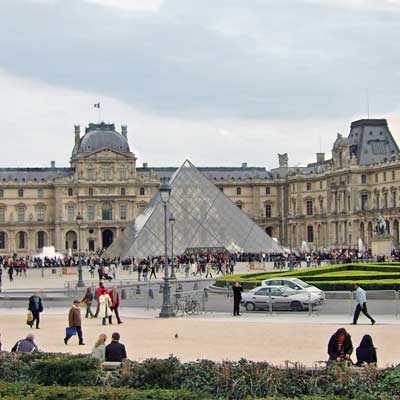
The Louvre with its distractive glass pyramid
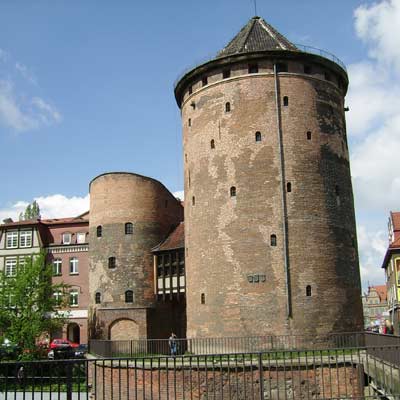
The Stągwie Mleczne was the ancient gateway to the southern side of Gdansk
Gdansk is surely at its best in the warmer months. Between May and September is when most travellers come. They get to enjoy all the al fresco bars along the old port. They can wander the Old Town without worrying (too much, at least) about rain. They can hit the open-air terraces to taste pierogi dumplings. The weather is a little milder than inland Poland thanks to the tempering effect of the Baltic Sea. Average highs in July are in the low 20s, but that's enough to bring crowds to the beaches of Sopot and the north coast.
The winter in Gdansk can be brutal. The Baltic magnetises icy storms and cold winds across the shoreline and the city. It's a time to get cosy in cute cafes and sip warm beers (yes, that's a thing here), but be certain to pack the thermal leggings and snow coats.
Paris is known for its café culture, it would be a shame to miss all those al fresco coffees on the canal side. Enjoyments like that are most likely to be had in the warmer months, which – this far north in France – means May to September.
Outside of those, the rainfall picks up and things get chilly. That said, the summer is the most expensive and busy part of the year, so you'll be contending with others for those selfies by the Eiffel Tower.
Visits pre-Christmas tend to be pricier than those after Christmas. If you're eager to cosy up and see Paris in the ice and cold, you might want to push your break to February or March. Those months tend to be nice, quiet and free from the tourist masses.
Paris is a master of art and culture. From the gold-gilded palaces of Versailles to the endless works of the Louvre and the Musée d'Orsay, you'll never be short on paintings or architecture or sculpture.
But the best Paris trips mix all that with a little bit of food, some classic sightseeing, and even a touch of hedonism. That makes this a versatile city-break option, offering wine bars and bucket-list attractions like the Eiffel Tower.
It's probably worth dodging Paris if you're not the sort who deals well with crowds, traffic, and big cities. The nearest place you can go to escape to nature are the forest parks on the outskirts. What's more, it can take a while to get from A to B in the French capital.
Gdansk has got loads going for it on the travel front. Melding enthralling medieval history with sobering tales of wartime and the proud trade union movement, it's a gem for those looking to unravel the history of Central-Eastern Europe. Shoppers get to delve into Amber shops galore – the city is hailed as one of the best places in the world to buy the glowing fossil. Hedonists get everything from basement bars to wild clubs in old bunkers that stay open all night. Sightseers need only look to the historic Old Town and its grand churches and squares.
Adding to all that, Gdansk has beaches. A quick train to Sopot will reveal one of the nicest in the region, with a long pier that juts out into the Baltic. A little further and you can get to Puck, which sits at the base of what is arguably Poland's finest length of coastline.
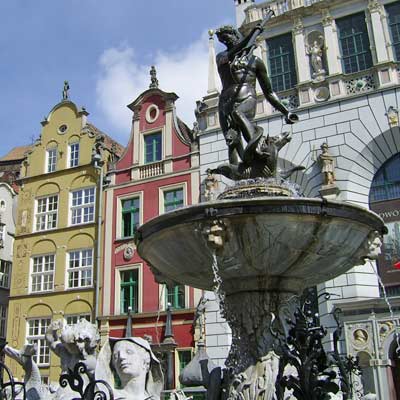
Neptune's Fountain in the historic centre of Gdansk
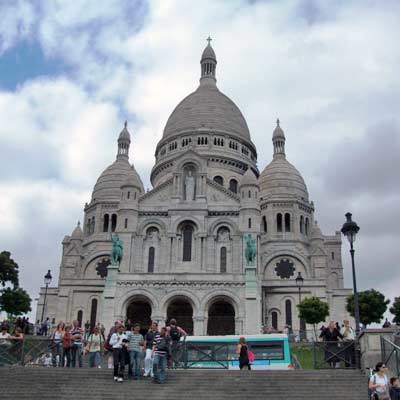
The Sacré-Cœur provides one of the finest view of Paris
Paris in 48 hours is a hard ask, but this itinerary should help distil the city's preeminent culture, art and atmosphere into two short days:
Day 1: Breakfast time in the 19th arrondissement. Local and traveller joints meet there, with some charming cafés and bakeries lining Le Bassin de la Villette, where there are open-air swimming spots in the summer months. Then, move south-west along the picturesque Canal Saint-Martin.
It takes you to the beating heart of the city, just shy of where the Île de la Cité hosts the beautiful Cathedral of Notre Dame. Take your photos and then move across the Seine River to the famous Latin Quarter.
It's the perfect place to explore in the afternoon, with boutique bookshops and atmospheric cafés aplenty. For the afternoon, cross the water again and duck into the Louvre Museum.
The morning rush should have subsided, so you can wander the exhibition rooms in search of the Mona Lisa and the Venus de Milo without having to jostle with too many. In the evening, return westwards to hipster Belleville. This district is one of Paris's Chinatowns, with more noodle shops and dim sum outlets than you can shake your guidebook at.
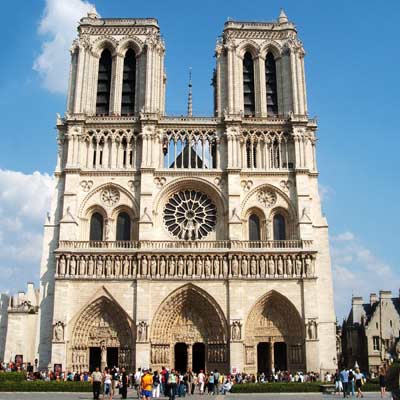
Notre-Dame
Day 2: Seek out the bohemian neighborhood of Montmartre to start your second day in Paris. It's known for its zigzagging cobbled streets and urban staircases, but also comes replete with cosy coffee houses with crispy croissants. At the very top of the hill where the district is draped is the gorgeous Sacré-Cœur. Its great travertine domes gaze over the city, so expect some awesome views.
On the way down, heading west, you might just pass by the infamous Moulin Rouge and its makeshift windmill all lit up in red neon. You can catch a metro from that to go along to Ternes. Emerge and you'll be looking straight down at the Arc de Triomphe, which marks the start of the Champs-Élysées – a place to shop till you drop.
Be sure to pull yourself from that grand boulevard with enough time (and light) left to see the Eiffel Tower in all its glory. The landmark is just over the river to the south, but the best view might be from the Trocadéro Gardens on the northern banks.
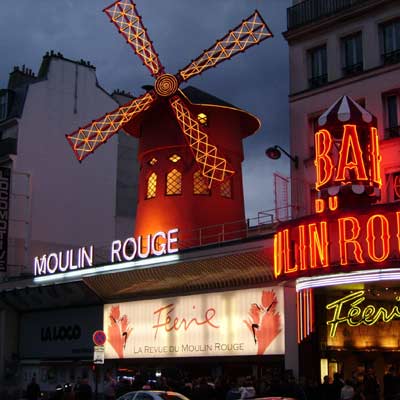
The Moulin Rouge
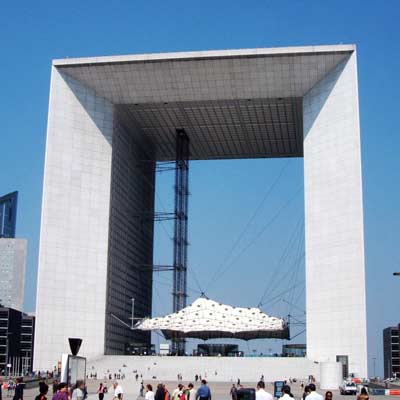
La Défense is the modern side to grand Paris
48hours in Gdansk
Gdansk has big-name sights like the iconic dockyards and its Old Town. But it also has secrets up its millennia-old sleeve. This 48-hour itinerary covers both, with a little bit of partying and beachside living thrown in for good measure…
The interactive map below shows a suggested route for the 48 hours in Gdansk, with day 1 highlighted in green and day two in yellow.
Day 1: Make for Cafe Libertas for breakfast. It's a popular spot with fruit bowls and artisan coffee that will fuel you up right in the heart of the Old Town. Stepping outside the door, you'll find quaint Chlebnicka street, which you can stroll between grand townhouses with Flemish-inspired façades.
At one end is Chlebnicka Gate, still flaunting its original medieval crest from 1450. Beyond is the riverside and the iconic Żuraw Crane. Now a branch of the National Maritime Museum, it's a great detour to make if you want to learn all about the history of shipbuilding in Gdansk.
Delve back into the maze of streets to the west and try to find the St. Mary's Church. It shouldn't be difficult – it's among the three largest brick-built churches on the planet! Past that is bustling Długa. The main drag of the city, it's awash with amber shops, bars, eateries and more.
Stop to sample some pierogi dumplings or grab a beer, and then move on to lovely Long Market square. That's where the famous statue of Neptune beckons, hemmed in by pastel-painted guilds. As evening arrives, return to Długa or Piwna street for basement bars that gush with vodka and cheap beer.
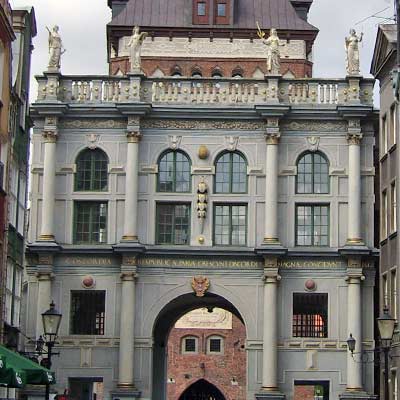
The Złota Brama (Golden Gate) is lined with figures depicting the qualities of the ideal citizen
Day 2: Morning of Day 2 takes you out to the legendary Gdansk Shipyards. If you haven't heard of these already, then buckle in for a history lesson in the fall of Communism. It was here, in 1980, that the powerful Solidarity movement first took route under the leadership of Lech Wałęsa. It would go on to fuel revolutions across the Eastern Bloc, which finished with the fall of the Berlin Wall and the end of Russian dominion in Europe.
There's nowhere better to uncover all that than at the European Solidarity Centre. A visit is likely to take a few hours, especially if you want to drop by the striking Monument to the Fallen Shipyard Workers of 1970 next door. For the afternoon, it's time to explore the Tri-City.
That means hopping on the SKM railway line from Gdańsk Główny. The ride to Sopot is only 15 minutes. It takes you to a lively resort area that's positively brimming with bars and eateries. It's also on the beach, so you might want to spend the evening here, moving between the music venues to famous Sopot Pier.

The European Solidarity Centre commemorates the Polish civil resistance and trade union which began in the Polish shipyards and ultimately led to the collapse of the communism in the USSR

Sopot has a beautiful beach and is an enjoyable destination during the summer season
Paris is served by two large international airports. Low-cost carriers typically use Orly. From there, you can hop to Anthony Train Station and then switch to the urban metro line to reach the city. The trip costs around €12 in total. The more famous and larger airport at Roissy Charles de Gaulle is for long-haul fliers and premium services. It's linked straight to the Gare du Nord station in the middle of the city by regular trains that take around 35 minutes from terminal to town.
Choosing the right area to stay in Paris is important because each arrondissement has its own distinct vibe. You can pay extra and be somewhere like Grenelle and the 7th, where you're most likely to open your hotel window and be gazing at the Eiffel Tower. Or, you can opt for a B&B somewhere like the Canal-Saint Martin – a vibrant, student favourite – or in the 11th arrondissement – cheaper and more lived-in.
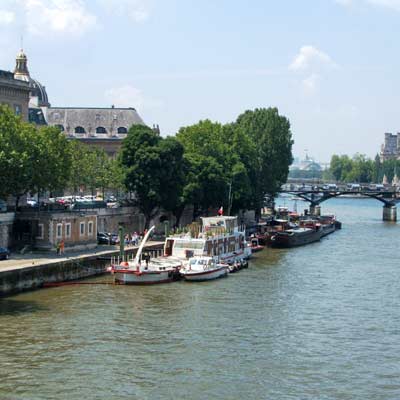
The Seine River meanders through the centre of Paris
The Parisian transport network is vast and efficient. Travelers shouldn't need more than the RER and Metro combination. They can be caught to virtually all the major sights and areas around the capital. You can purchase a contactless card ticket to travel on all the lines – tariffs are €1.90 per ride.
Even among the French themselves, the Parisian people are renowned for being curt and a little rude. Remember that this is a working, living metropolis, so expect central areas to be busy with commuters and the like. You'll also want to be especially cautious on public transport when carrying large luggage or travelling at night, because pickpocketing and thefts certainly aren't unheard of.
Getting to Gdansk by plane is easy because of the countless short-haul and low-cost carriers that now fly into the local Lech Wałęsa Airport. A mere nine miles outside of the centre, you can get to the terminals on the 210 bus from the main train station. There are often problems with scam taxi fares to and from the airport, so always agree a rough price beforehand (the normal rate is between 60-80 PLN).
Gdansk's Main City is a joy to walk. The streets of Długa and the quays are all connected by loads of hidden alleys and paths. It might pay to have a tourist map at hand because getting lost is almost inevitable if it's your first time in town.
To travel to the beaches, the shipyards, and Sopot, you'll need to make use of the trams and inter-city SKM trains. The former cost 3.2 PLN per ride. Tickets are available from vending machines at most stations. Be sure to validate as you board.
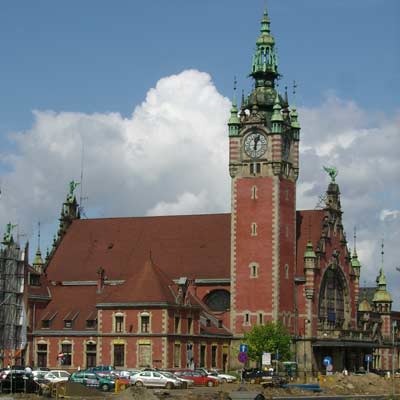
Gdansk Glowny - the main train station of Gdansk
The best location for a hotel in Gdansk is certainly in the Old Town area. There, you'll get boutique lodgings and stylish aparthotels set in centuries-old buildings. An alternative for those who favour beaches and nightlife would be to bed down in Sopot, where resort hotels with swimming pools and stylish restaurants are the norm.
Gdansk is among the most liberal and welcoming of Polish cities. It's got a vibrant LGBT scene and incidents of racism and crime are relatively rare. Still, there are still tensions in Poland and it's wise to be on your guard, especially if out at night in the bars of the Old Town.

oh we were stuck in the airport!

Copenhagen was a bit expensive...

All we did was drink beer in Brussels...

Muncih was crazy

And we got so burnt!

Remeber that night in Rome

oh we were stuck in the airport

So much fun kayaking

Berlin and that group from Austria!

There was such a view from that church

And we got so burnt!

Munich was eventful, wasn't it!

Such a view from that cathedral in Florence

Lisbon was such so much fun

Last summer was so much fun .... x

Remeber that night in Rome

Lisbon was such so much fun

Such a view from that cathedral in Florence

Munich was eventful, wasn't it!

And we got so burnt!

Remeber that night in Rome

All we did was drink beer in Brussels...

Berlin and that group from Austria!

Can't wait to go back to Dubrovnik

Remember that boat ride in Prague

Copenhagen was a bit expensive...
